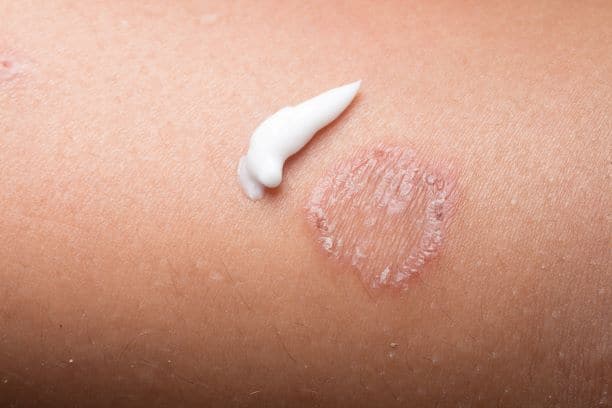Ringworm is a common skin condition that can impact adults, children, and animals. Caused by fungi found in the soil, almost anyone is at risk for ringworm, and once the fungal spores are attached to the skin, it can be spread to other people or animals even before symptoms appear. Because it’s so easy to contract and spread ringworm, this condition is treated frequently by the skilled dermatologists at U.S. Dermatology Partners, including Dr. Sindy Pang who says, “Ringworm is very common, especially among children and teens. It’s easy to spread from person to person, but it’s also easy to transfer to multiple parts of the body. For this reason, it’s almost always best to consult with a dermatologist for diagnosis and treatment to ensure you address all potentially infected areas.” Dr. Pang of Medical Center Dermatology, a U.S. Dermatology Partners affiliate office in Houston, Texas, shares answers to some of the most frequently asked questions about ringworm in this blog.
What is Ringworm?
First and foremost, ringworm does not actually have anything to do with worms, so you don’t need to worry about that. Ringworm is the name given to a variety of fungal skin infections, including very common conditions like athlete’s foot and jock itch. Ringworm is medically diagnosed as dermatophytosis, dermatophyte infections, or tinea infections. Specifically, there are five types of tinea infections:
- Ringworm of the skin – tinea corporis
- Athlete’s foot (soles of feet) – tinea pedis
- Ringworm of the hands (palms of hands) – tinea manuum
- Jock itch – tinea cruris
- Nail infection – tinea unguium or onychomycosis
What are the Symptoms of Ringworm?
Ringworm takes its name from the appearance of the rash that commonly appears in ringworm on the body (tinea corporis). These rashes are usually circular, and around the edge, the rash has a raised, rippling appearance that can resemble a worm. However, the side effects and appearance of ringworm vary depending on where the rashes are located. For this reason, it’s important to receive a diagnosis and treatment plan from a dermatologist. Some common symptoms you can look for include:
- Itching and rashes
- On light skin, rashes will be red-colored
- On skin of color, rashes may be gray or brown-colored
- Raised or scaly patches on the skin
- Hives, blisters, or pustules
- Rashes with raised, darker-colored, or defined edges
- In the nails, you may notice thickening, discoloration, and cracking
- In the scalp (most common for kids), you may notice itching, flaking, or thickening skin and hair loss
What Causes Ringworm?
Ringworm is caused by the growth of one of three types of fungi – Trichophyton, Microsporum, and Epidermophyton. Ringworm fungi spores attach to the skin from direct contact with the soil where it grows. Ringworm is also spread through contact with other people or animals who have been infected with fungal spores. The spread of ringworm is very common among children as the spores can be transferred even before rashes and other symptoms are visible on the skin.
How is Ringworm Prevented?
It can be difficult to prevent ringworm, but the following are steps you can take to reduce your risk and stop the spread:
- Know your risk – Ringworm fungi are more common in the soil of warm, humid climates, so if you live in an area that fits this description, make sure you address itching or rashes as soon as they appear.
- Clean and sanitize – Wash hands often and clean and sanitize spaces regularly. Cleaning can be especially important in places like gyms, locker rooms, and public pools where the heat and moisture promote fungal growth.
- Educate kids & caregivers – Kids are often carriers of ringworm, so schools and daycare centers should be knowledgeable and prepared to address this condition and prevent the spread of ringworm.
- Stay cool & dry – Wear loose clothing. Avoid being outdoors for long periods in heat or humidity. Shower right away after excessive sweating, and make sure to thoroughly dry skin after bathing.
- Don’t share – Most of us were told to share and share alike as kids, but sharing hairbrushes, hats, sporting equipment, clothing, towels, and other items can spread ringworm.
- Get treatment for pets with ringworm – Humans can contract ringworm from pets with this fungal infection. If you notice your pet is itching or they have bald spots in their coats, you should take them to the vet and avoid or limit contact until the infection is cleared.
How is Ringworm Treated?
According to Dr. Pang, “Some types of ringworm can be treated with over the counter medications, but it can be difficult to completely remove all the spores, especially in areas of the body that are asymptomatic. It can take weeks or even months to completely clear up ringworm with over the counter medications. In some cases, prescription products will help to speed up the healing process, and ringworm in some areas will not clear up without professional intervention.” Treatment for your individual case will depend in large part on where symptoms appear. We may recommend the following specific treatments for ringworm based on the symptom area:
- Skin – For just a few, localized rashes, over the counter creams can clear up the condition, but for those who have more extensive coverage or rashes that don’t clear within a few weeks, prescription antifungal medication may be recommended.
- Groin – Treating jock itch usually involves using an over the counter spray, cream, or powder for about two weeks. You’ll also need to take care when cleaning the area and avoid excessive heat, moisture, and sweating. If the infection doesn’t clear within a few weeks, you may need to receive more advanced treatment from your dermatologist.
- Feet – Athlete’s foot is often cleared with over the counter creams or sprays. In rare cases, a dermatologist may need to prescribe stronger antifungal medications, especially if the fungus spreads to the nails.
- Hands – In many cases of ringworm of the hands, a professional treatment plan is needed due to the risk of spreading the fungus to other parts of the body, including the risk of spreading to the nails which requires treatment with prescription antifungal medications.
- Scalp – You will need to take a prescription medication and use antifungal shampoo to clear ringworm in the scalp. It can still take weeks or months to clear this stubborn form of fungal infection, but if you follow treatment recommendations, you should achieve the desired result.
- Beard – Unfortunately for those who love their beards, ringworm typically requires hair removal. You’ll also need to take prescription antifungal medications, and it may even be necessary for the dermatologist to perform more advanced treatments, including removing tissue to promote healing.
- Nails – It is very difficult to completely remove ringworm of the nails. In most cases, treatment involves months of prescription oral and/or topical antifungal medications and follow up visits with the dermatologist to check progress and reassess. When ringworm occurs in fingernails, it can be very easy to spread the fungi to other parts of the body, so you will receive a preventive treatment plan to avoid spreading ringworm or re-infecting other areas. In extremely severe cases, the nail may need to be removed.
Should I Call a Dermatologist for Help with Ringworm?
Many types of ringworm can be treated with over the counter products that relieve the associated itch and rash, but ringworm can spread to other parts of the body, and if you don’t treat all affected areas, the condition will come back. To make sure all affected areas are treated and that you’ve completely removed ringworm from stubborn areas like the nails, working with a dermatologist is essential. According to Dr. Pang, “Many people think they have chronic ringworm or that they keep getting re-infected, but actually, the condition never completely cleared up. This is especially true for ringworm on the nails and in the scalp.” If you need the help of a dermatologist for the treatment of ringworm, Dr. Pang and her team in Houston, TX., would be happy to help. If you don’t live in the Houston area, there are numerous U.S. Dermatology Partners locations, and we make it easy to find the practice nearest to your home or office. Simply fill out our online request form. A U.S. Dermatology Partners team member will be in touch soon to answer your questions or schedule an appointment.
Find a location near me
or


